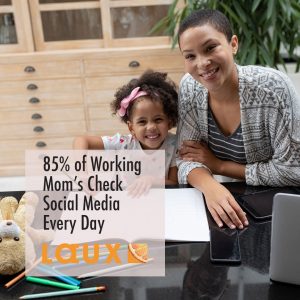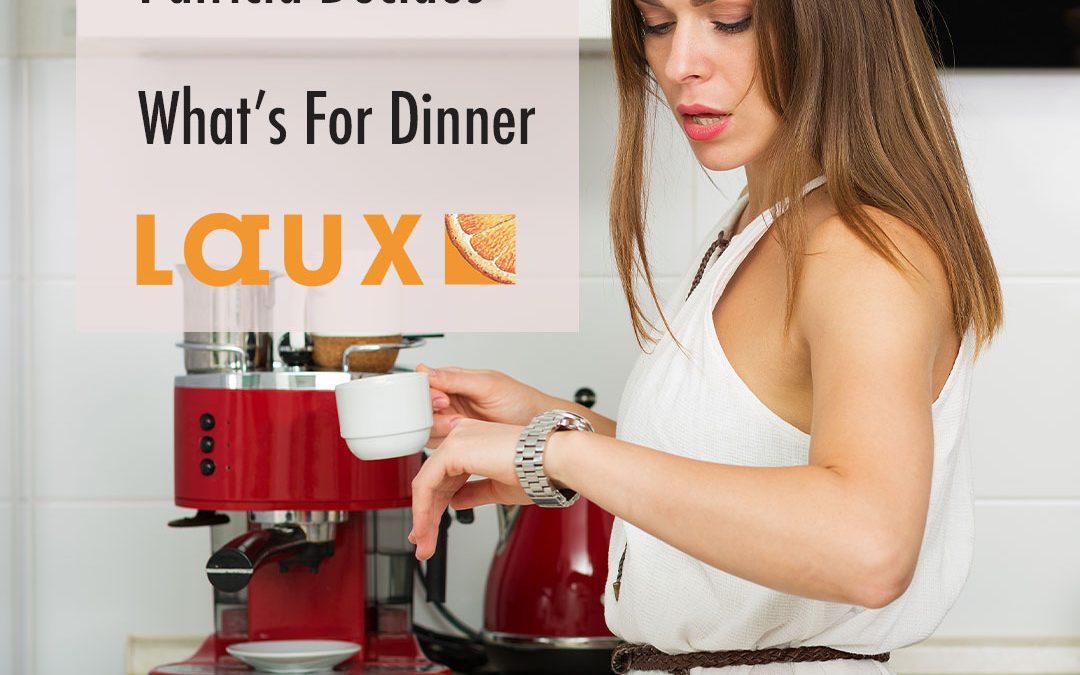 How Patricia Decides What’s For Dinner (and where to get it)
How Patricia Decides What’s For Dinner (and where to get it)
This is a story about how Patricia decides what’s for dinner and where to get it. It’s a story about a busy life filled with hundreds of other decisions that include friends, maybe some children, her husband or partner, pets, running a household, and working or doing volunteer work. All of this chaos influences her decision about dinner, and the final decision probably isn’t made until late in the day.
6:30 AM Patricia’s first thoughts about food.
Patricia is in her thirties or forties, married with a couple of kids, a dog or a cat, she works and takes care of a modest home. The alarm on her phone goes off at 6:30 in the morning, so she reaches over to her nightstand, picks up her phone and shuts off the alarm. Maybe it’s a Tuesday, or Thursday, at the moment, she can’t remember. But her day is just beginning and she has already had her phone in her hand.
In fact, like many people, she opens her Facebook app on her phone and scrolls to see what’s happening in her extended world before she gets out of bed. She glimpses at her friends and their lives and feels a little jealousy at what looks to her like the perfect life. Along with her friends and extended family, he sees local businesses, and even a little news. Then she switches over to InstaGram and looks at all the photos people have posted. Some of the posts on both sights are from people she knows, others are simply people she follows for various reasons. She also sees some of the local restaurant posts. The restaurants with the nice food photos catch her eye, but she’s not hungry at the moment, so she scrolls on without engaging. 
Secretly, she compares her post engagement to other people. I know it sounds silly, but she wants to be popular, even at her age. So when she sees a friend or her sister with more likes and comments than her, she feels even more jealous. As she is thinking about how her posts are being received, she sees more photos of food. The best photos and comments are remembered positively, the poor quality photos are quickly forgotten.
7:15 AM Ready to wake the house and have her first cup of coffee.
After showering and getting dressed, (and not until she has had her first cup of coffee) she starts to wake the rest of the family. Her husband is awake already and looking at his phone, scrolling through the news, and social media. He has not gotten out of bed yet, but he is working toward it. He, too, notices the nice food photos, and his appetite in the morning is stronger than Patricia’s, so his stomach grumbles. He may not engage the posts that stir his appetite, but the photos have made an impression on him. The photos make an impression, either way, good or bad, depending on the image quality and the post text.
11:15 AM Thinking about lunch with her kids.
Because of COVID, Patricia is working from home, and her kids are on a rotating schedule at school, with some days studying at home and other days in class. This has made it difficult for Patricia to stay organized, but she wants her kids to be safe above all else, so she does everything she can to accommodate. Most breakfast and lunches are at home, but Patricia gets tired of cooking and wants a break now and again. She doesn’t feel completely safe taking the kids to a restaurant, so the only food away from home is coming from the deli at the grocery store, or a place with a drive thru window, and the local pizza place every once in a while. From time to time she orders something for delivery or carryout locally, but that has been hit or miss for food quality, and she hates to waste money on food that is much better at the restaurant.
One of the things she misses most about her life is meeting up with friends and family at a local restaurant. She dreams about having a couple of glasses of wine, maybe some appetizers and a meal, but it’s the connections that she is missing most. Just sitting in a restaurant with people not in her family and having a break from life.
3:15 PM Patricia peeks at social media.
During her normal day, about every couple of hours, Patricia will log on to Facebook, or Twitter, or InstaGram, or SnapChat, or TikTok and check in. She scrolls through her newsfeed and glances at what everyone is up to. She notices some of the food shots from local restaurants. She even likes a couple of the nicer photos, or the more engaging content. She may even comment, but more important, the food photos have made an impression on her. The best times to catch her are just before lunch, about mid afternoon, late in the afternoon when she is winding down, and then after dinner while she is watching TV and scrolling social media.
 Late in the afternoon she starts to think about dinner. If she were well organized, she may have already taken something out of the freezer and is preparing it for the oven, or stove. Maybe she already has something in the slow cooker, but most days are decided after four in the afternoon. She texts her husband and asks what he might want. The answer is frustrating to her: “I dunno, what do you want?” At this moment, she is not consciously remembering the photos from restaurants she saw throughout the day. Those food shots are nothing but a vague memory in the back of her mind. But those restaurants are more top of mind than the restaurants who have not posted in a while.
Late in the afternoon she starts to think about dinner. If she were well organized, she may have already taken something out of the freezer and is preparing it for the oven, or stove. Maybe she already has something in the slow cooker, but most days are decided after four in the afternoon. She texts her husband and asks what he might want. The answer is frustrating to her: “I dunno, what do you want?” At this moment, she is not consciously remembering the photos from restaurants she saw throughout the day. Those food shots are nothing but a vague memory in the back of her mind. But those restaurants are more top of mind than the restaurants who have not posted in a while.
4:30 PM Patricia starts to decide what’s for dinner (this time for real).
Maybe she decides to have pizza. The kids like it, and it’s filling and easy. It also travels well. Where she orders it from has a lot to do with the social media she has consumed during the day. If there was a nice photo of pizza, she’ll remember it. Or maybe it’s meatloaf from a local place that has that nice provolone cheese and mushrooms in the middle. Or maybe a nice burger with fries would hit the spot. Again, none of these items are going to be purchased from a restaurant that hasn’t been active in her newsfeed in a long while. She simply isn’t carrying them top of mind. Unless she hears from you, she isn’t thinking about you. It is that simple.
Are you thinking like Patricia, or are you thinking like a food company?
Most food companies do not take social media seriously enough. That’s because they don’t see an immediate return on investment. People like Patricia simply don’t tell the restaurant they saw them on Facebook or InstaGram, so food companies don’t always understand the impact of those platforms to influence Patricia’s behavior. Most food companies see their social media through their own eyes, not through the eyes of people like Patricia or her husband. For this reason, the idea of using a professional social media resource seems expensive and disconnected from their business. They think: if only a marketing firm could offer an exact return on investment they might sign up. Tell them, if you spend this, you will get that, down to the first order from Patricia or someone like her.
Except social media, like all advertising, is an influencer. It’s not a gun to Patricia’s head forcing her to buy now or else. It’s a gentle nudge, or a whisper in her ear. It’s a relationship built over time. Social media is about building trust and positive thoughts. When Patricia sees your posts over time, she becomes familiar with your brand and what you offer. When she orders from you and tells you the French fries were soggy and you answer her properly, she forgives you and gives you another try. If you have corrected your fries before her next order, she may even give you a positive review. Patricia’s average number of friends on Facebook is 338 people (brandwatch.com), all of whom may like Patricia and listen to her suggestions. If someone asks where she gets pizza, she may even think to mention your business.
Social media works, but it’s not a cash machine.
Most smart food businesses are posting two or three times per day. They post on a regular basis, and they repeat their posts. Many food companies worry that if they repeat their posts, people will get tired of seeing them and stop following them. But this is not true at all. Again, you have to see social media through the eyes of Patricia. She isn’t looking at your page and scrolling through everything you post. She is looking for her friends, or family, or the latest fashion trend.
 Smart business operators are also using professional help for a couple of reasons. First, professionals will post on a regular basis and not skip any posts because they are paid to be consistent. Secondly, a good marketing firm will be better able to get inside Patricia’s head and make your posts stick. They will get Patricia to think better of you and your products. If they are really good, they will come to you with ideas on your food, what people are saying and how to improve your business.
Smart business operators are also using professional help for a couple of reasons. First, professionals will post on a regular basis and not skip any posts because they are paid to be consistent. Secondly, a good marketing firm will be better able to get inside Patricia’s head and make your posts stick. They will get Patricia to think better of you and your products. If they are really good, they will come to you with ideas on your food, what people are saying and how to improve your business.
Open your mind and think like Patricia.
Most food service companies have not thought about Patricia or people like her in any meaningful way. They see the world through their own, narrow view of the world. To reach people like Patricia and get them to buy from you rather than someone else, you will need to open your mind and think differently. Taking social media for granted, or worse, plugging away at it on your own and thinking it isn’t worth a lot of effort is essentially telling people like Patricia that they don’t matter.
Here’s the takeaway: reach out to people like Patricia in a professional manner and grow your brand awareness and your sales. Invest money with skilled professionals who understand how to get into your potential customer’s heads and lives. It’s time to see the world the way Patricia sees it.
Contact our sister company HotOperator.com here.



Recent Comments